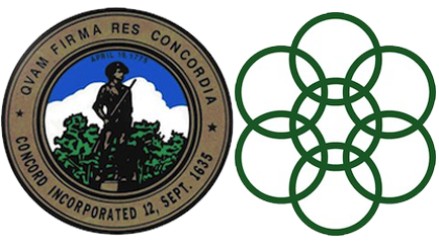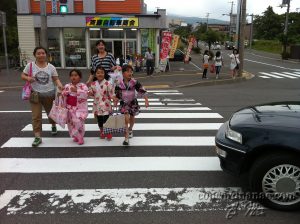By Ben Mirin, CIR
As seen in The Concord Journal column, “The Japan Connection.” Stay tuned for pictures on Concordnanae’s Flickr Photostream and Photo Gallery!
July 4, 2011
Hold the bachi at your navel. Is it touching the surface of the taiko? If not, go lower.
With this mantra in mind, I assumed an increasingly strenuous stance alongside the rest of my family as we merged mid-song into the ranks of Nanae Danshaku Daiko Sosakukai, the Nanae taiko drumming ensemble. Before an audience of nearly one hundred Japanese town office workers, English students, and high-school students, the latest delegation from Concord, MA, struggled to keep the beat.
Like every other day in Nanae, tonight was another chance for my family to be a part of something extraordinary. Eight days had passed since their bleary-eyed arrival at Hakodate Airport. Now, at the farewell potluck party in Nanae’s Bunka Center, Japanese friends from every part of my multifaceted life in the sister city had converged in one place, to treat us one final time as special guests in their community.
The days leading up to the farewell potluck were filled with a rich variety of events and excursions. At the center of the schedule were the routine responsibilities of the CIR. My family visited four of my six English conversation (eikaiwa) classes, toured the town office, ate dinner with Mayor Nakamiya, and made origami with the children of Donguri Kindergarten. With incredible help from Koji Teraya and Emi Kimura (International Relations), we also managed to go sightseeing in Onuma Park and Hakodate. We played park golf, went fly-fishing in Nanae’s Ookawa River, and went bird watching in Onuma and southern Kameda. We even attended a big-band jazz concert in Hakodate’s Public Meeting Hall, and enjoyed a fabulous cooking class with my eikaiwa student, Yoko Sato.
Our final day in Nanae began with a visit to Nanae High School, where we arranged to have a special meeting with Principal Kogoshi before attending the Tea Ceremony and English clubs and the brass band rehearsal. Enthralled by the brass band’s final piece, a stellar rendition of the Super Mario medley, we barely made it to the Bunka Center before Nanae’s Vice Mayor, Shuichi Baba, began his official address to open the Mirin family potluck party. Continue reading “The Mirin Family Visits Nanae”




